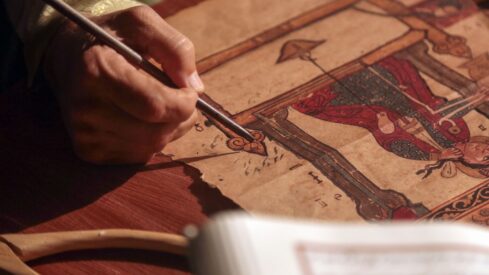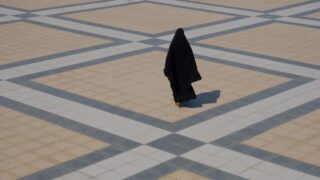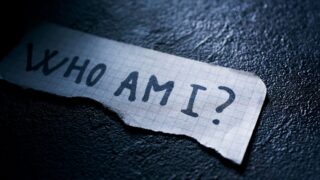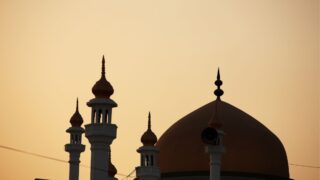Just over 21 years ago, I wrote an article for New Scientist entitled ‘Can science come back to Islam?’ (23 October 1980). I was simply articulating a question that was on the lips of many Muslim scientists and scholars. The beginning of the 1980s, with OPEC power at its peak, the Iranian revolution and a growing consciousness in Muslim societies of their cultural identity, was a period of particular optimism in the Muslim world. It led many scientists and academics as well as institutions to emphasize the distinctive scientific heritage of Islam. One essential component of any cultural revival, many people argued, had to be the recovery of the spirit and values of Islamic science. Muslim societies were ready, as one scientist told me, to make science an integral part of their culture.
The achievements of Islamic science, I reported, were conspicuously absent from the history of science. Objectivity and fair play demanded that the history of science in Muslim civilization was given its due important and rightful place in the overall scheme of the history of science. We also needed to identify the motives, and underlying values, of scientists like ibn al-Haytham (d. 1039), who discovered the laws of reflection and refraction, and al-Biruni (d. 1048), who measured the circumference of the earth and discussed the rotation of the earth on its axis. How can we encourage these values in Muslim cultures today? How could we direct science to meet the needs and requirements of Muslim societies? And how could we inform science, which is far from a neutral activity, with Islamic values? These were the questions I raised in the article.
The article kicked off a global debate. The notion of Islamic science came under intense scrutiny in a series of international conferences and specially commissioned studies. The debate crystallized around three issues. What Islamic science had achieved in history? What was ‘Islamic’ about Islamic science? And, finally, did the very idea of ‘Islamic science’ have any contemporary relevance?
So, what has been achieved two decades on
It is in the history of Islamic science that main progress has been made. We now know much more not just about the quality of Islamic science but also its staggering quantity. From astronomy to zoology, there is hardly a discipline which did not receive the attention of Muslim scientists and hardly an area where they did not make some sort of original contribution. Recently, we have learned that the mathematical models of 14th century scientist ibn Shatir, and the work of astronomers at the famous observatory in Maragha, Azerbaijan, built in the 13th century by Nasir al-Din al-Tusi, laid the foundation for the ‘Copernican revolution’. The Maragha astronomers developed the Tusi couple and a theorem for the transformation of eccentric models into epicyclic ones.
Copernicus not only used these two basic theorems to build his notion of heliocentricity but also used them at exactly the same point in the model. Much of the new historic research has now been synthesized in test books, the best being Donald Hill’s Islamic Science and Engineering (Edinburgh University Press, 1993). Moreover, a three volume, concise Encyclopedia of the History of Arabic Science (edited by Roshdi Rashed, Routledge: 1996) is now also available.
Even Ottoman science, associated with the decline of Muslim civilization, turns out to be a rather fruitful period. The massive project on the ‘scientific literature in the Ottoman period’, carried out under Ekmeleddin Ihsanoglu at the International Research Centre for Islamic Culture and Arts (IRCICA), Istanbul, turns the conventional view that science disappeared in the Muslim world in the fifteenth century upside down. Far from ‘declining’, Ihsanoglu and his collaborators have shown that science was very much alive right up to the eighteen century when it shifted towards learning and assimilating European sciences through translations and adaptations.
How could modern Muslim societies rediscover this spirit of scientific inquiry? This question was discussed at numerous conferences and seminars held in such places as Riyadh, Islamabad, Aligarh, Kuala Lumpur and Rabat. One particular study in the early eighties, sponsored by International Federation of Institutes of Advance Studies in Stockholm, tackled the question head on. The study concluded that the issues of science and values in Islam must be treated within a framework of concepts that shape the goals of a Muslim society. Ten fundamental Islamic concepts were identified as constituting the framework within which scientific inquiry should be carried out, four standing alone and three opposing pairs: tawheed (unity), khilafah (trusteeship), `ibadah (worship), `ilm (knowledge); and halal (lawful) and haram (unlawful), `adl (justice) and zulm (injustice), and istislah (public interest) and dhiya (waste). It was argued that, when translated into values, this system of Islamic concepts embraces the nature of scientific inquiry in its totality; it integrates facts and values and institutionalises a system of knowing that is based on accountability and social responsibility. The pursuit of scientific inquiry, the study suggested, should be seen in a Muslim society as a form of worship, promoting inquiry and thought, public interest and social justice.
The framework was widely debated and criticized. Not least in the pages of the Journal of Islamic Science which started publication in 1985 from the then newly established Center for Studies on Science in Aligarh, India. It is important to realize that science in this framework is defined as systematic observation and experimentation leading to model construction and theory building that generates universal knowledge. Much as ar-Razi’s (d. 925) detailed and highly accurate clinical observations provided us with a universal model of small pox or the kind of accurate observations and theory building that led Muslim astronomers in the twelfth century to launch a rigorous attack on the imperfections in Ptolemaic astronomy and declare, in the words of Ibn al-Haytham, that ‘the arrangements proposed for planetary motions in the Almagest were “false”’. However, in the early nineties there was a definite shift away from this methodology and towards more obscurantist and dangerous directions. The Islamic science discourse now follows the way of the Taliban.
This shift has two main components. The first is based on the fundamentalist idea that all knowledge, including scientific knowledge, can be found in the Qur’an.
Backed by a lavishly funded Saudi project, ‘Scientific Miracles in the Qur’an’, this tendency has spouted a whole genre of apologetic literature (books, papers, journals) looking at the scientific content of the Qur’an. From relativity, quantum mechanics, big bang theory to the entire field of embryology and much of modern geology has been ‘discovered’ in the Qur’an. Conversely, ‘scientific’ experiments have been devised to discover what is mentioned in the Qur’an but not known to science – for example, the program to harness the energy of the jinn that enjoyed much support in the mid-nineties in Pakistan! This highly toxic combination of religious fundamentalism and ‘science’, akin to the Creationists, does not just accept all science as Good and True, but attack anyone who shows a critical or skeptical attitude towards science and defends its own faith as ‘scientific’, ‘objective’ and ‘rational’. Unfortunately, it is now the most popular version of ‘Islamic science’.
The second component can best be described as mystical fundamentalism.
In this perspective, Islamic science becomes the study of the nature of things in an ontological sense. The material universe is studied as an integral and subordinate part of the higher levels of existence, consciousness and modes of knowing. Thus, here we are talking about science not as a problem solving enterprise and socially objective inquiry but more as a mystical quest for understanding the Absolute. In this universe, conjecture and hypothesis have no real place; all inquiry must be subordinate to the mystical experience. This tendency is led by the Iranian scholar and charismatic mystical master, Syed Hossein Nasr. For Nasr, and his students and followers such as the Malaysian philosopher of science Osman Bakr and American mystical scholar William Chittick, all science in the Muslim civilization was ‘sacred science’, a product of a particular mystical tradition that traces its roots to the Greeks Neo-Platonists. In his historical works, Nasr has concentrated exclusively on such matters as the occult, alchemy and astrology at the expense of vast amount of work done on exact sciences in an attempt to show that Islamic science in history was largely ‘sacred science’. Nasr’s rewriting of Islamic history of science has been strongly refuted not just by Muslim historians of science like Faut Sagzin and Ahmad al-Hassan but also by a string of Western historians such as David King and Donald Hill.
Nevertheless, for mystical fundamentalism ‘Islamic science’ does not mean science as it has existed in Muslim tradition and history, but esoteric products produced within the tradition of Islamic mysticism or Sufism.
The mystical tendency has now become the academic orthodoxy. From Kuala Lumpur to Islamabad, this is what is being taught under the rubric of ‘Islamic science’. The recent special issue on ‘Islam and Science’ of the prestigious journal Islamic Studies, for example, is devoted almost exclusively to the notions of time and space in mystical thought, the cosmology of certain Sufi groups, mystical principles in natural theology and other similar topics. The issue is guest edited by Muzaffar Iqbal, a Pakistani mystical (al)chemist, who has recently established a Centre for Islam and Science, in Sherwood Park, Canada. Iqbal’s institution, supported by the Berkeley based Centre for Theology and Natural Sciences, exclusively promotes Nasr and his accolades.
Which is why I feel a strong sense of déjà vu. After saving Europe from itself by preserving and taking forward scientific basics from ancient Greece, which could so easily have been lost in the Dark Ages, science in Muslim civilization can only ever be marginalized by obscurantist and mystical tendencies. Now we are seeing a rebirth of these tendencies, and dislodging them will take considerable courage and will. Ironically, and sadly, while quoting the scientific achievements of Muslim civilization has almost become a cliché, a genuine revival of Islamic science now appears rather remote.
But still I dream of what might have happened if we had been able to develop Islamic science. Surely it could not have failed to help transform Muslim societies into knowledge-based societies? When the debate on this issue briefly came to the fore in Pakistan during the 1980s, it generated tremendous public discussion. It was widely recognized that any Islamic science worthy of the name must involve the citizens. That assumed an aware and well-informed public. But when it became clear that public interest and budgets spent on educating the people would actually lead to dramatic changes in Pakistan’s science priorities (for example, away from an emphasis in nuclear research), the debate was officially suppressed.
The right kind of science would also have encouraged research that was fine-tuned to solve local problems. Diarrhea and dysentery in Pakistan, flood control in Bangladesh and tackling schistosomiasis or bilharzia in Egypt and the Sudan would have replaced the international agenda that is blindly adopted in many Muslim countries.
Moreover, certain specifically “Muslim” problems would have become research priorities. Consider, for example, that almost three-quarters of all the political refugees in the world are Muslims. Centers of excellence devoted to the problems of refugees could have developed materials for quick and clean temporary housing, efficient and cheap ways of supplying emergency water, better techniques for providing basic healthcare and so on, ad infinitum.
Indigenous knowledge, too, would have received a tremendous boost. Muslim countries have a valuable, although largely untapped, reservoir of expertise in medicine, agriculture and husbanding natural resources. Islamic medicine and healthcare, for example, led the world for some eight centuries–before the 18th century, when research into and teaching of Islamic medicine was prohibited by the colonizing powers.
Similarly, traditional agricultural and water management systems have proved highly effective and ecologically sound. For example, traditional chain wells, known as karez in Persian and qanat in Arabic, have been shown to be superior to modern irrigation schemes. These ingenious systems consist of one or more mother wells, drained through a network of tunnels. For centuries before the arrival of tubewells, the ecologically sound and the exceptionally durable qanat supplied most of the water for irrigation to villages and towns throughout the Middle East.
There are also big philosophical questions just waiting to be asked. What happens to modern science if its basic metaphysical assumptions about nature, time, the Universe, logic and the nature of humanity are replaced with those of Islam? If nature, for example, is seen not as a resource to be exploited but as a trust to be nursed and nourished? What would then replace vivisection as the basic methodology of biology? Human values are considered not so much as external to science but as totally internal and integral part of science. How would that change science itself?
The truth is that it is only in the rewriting of the history of Islamic science that progress has been made. We now know much more, not just about the quality of Islamic science but about its staggering quantity. Recently, for example, we have learned that the mathematical models of 14th-century scientist ibn al-Shatir, and the work of astronomers at the famous observatory in Maragha, Azerbaijan, built in the 13th century by Nasir al-Din al-Tusi, laid the foundation for the Copernican revolution. The Maragha astronomers developed the Tusi couple and a theorem for the transformation of eccentric models into epicyclic ones. Copernicus not only used these two basic theorems to build his notion of heliocentricity, but also used them at exactly the same point in the model.
Thankfully, much of the new historic research has reached the textbooks. The best synthesis is Donald Hill’s Islamic Science and Engineering (Edinburgh University Press, 1993), while a three-volume, concise Encyclopedia of the History of Arabic Science edited by Roshdi Rashed (Routledge, 1996) is also available.
Great stuff, all of it. But still history, and not happening tomorrow–and certainly not today.
“Ziauddin Sardar’s Introducing Science has just been Icon Books in London and Totem Books in New York.”
By Ziauddin Sardar
Ziauddin Sardar: A cultural critic, Muslim scholar, author of many books, and editor of Futures: The Journal of Planning, Policy, and Futures Studies. His newest book is Ziauddin Sardar’s A-Z of Postmodern Life (Visions Publications, Feb 2002).He is based in London.
















